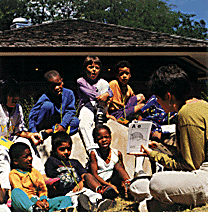![]()
From ferrets to foxes to salamanders and snakes, the Pritzker Children's Zoo provides visitors of all ages with an intimate introduction to the world of animals. Specially chosen wild and domestic critters of all kinds may be touched, allowing children and adults to learn and appreciate the importance of animals. Zoo docents help educate visitors of all ages with regularly scheduled informational programs in the main Children's Zoo and the animal area outside.
![]()

With a waterfall, meandering stream and stepping stones, the outside garden provides beautiful surroundings for the habitats of snowy owls, white-tailed deer, bobcats, raccoons, woodchucks and otters, all North American animals. In the summer, classes are taught outside as well.

![]()
Most of the animals at the Children's Zoo are not endangered, however, they all serve an important purpose. By instilling in children of all ages an appreciation of animals, insects and other creatures through hands-on interaction , we are working to insure the survival of even the smallest members of the animal world. |
![]()
| The glass-enclosed zoo nursery is an isolated area for baby animals whose parents are unable to take care of them for a variety of reasons. Animal keepers provide foster care for these zoo babies who need nurturing and rearing. Zoo babies who need special attention, from birds to gorillas are given an extra dose of TLC at the nursery. |
![]()
Conservation Station is a bright, fun-filled learning space with a variety of activity stations that reveal the importance of taking care of our environment and what we can do to make a difference. Interactive computer programs teach about conservation, geography, recycling and endangered animals. Examinations of human and animal x-rays show natural adaptations and diversity. A letter-writing station, complete with a mailbox, encourages children to write to elected officials to express their conservation concerns. |
 Inside the Children's Zoo there are mammals like guinea
pigs and hedgehogs; birds including owls and parrots; turtles and lizards
representing reptiles; the arachnid tarantula; and even insects, like the
multi-legged millipede. Many of these animals may be touched under staff
supervision.
Inside the Children's Zoo there are mammals like guinea
pigs and hedgehogs; birds including owls and parrots; turtles and lizards
representing reptiles; the arachnid tarantula; and even insects, like the
multi-legged millipede. Many of these animals may be touched under staff
supervision.